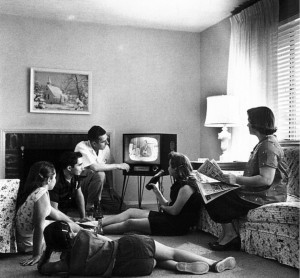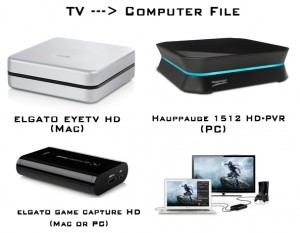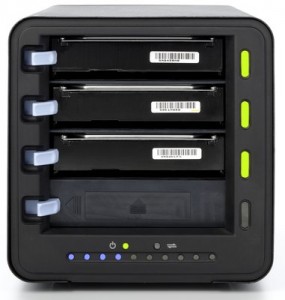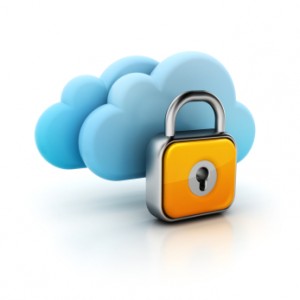Teach Hacks: How to Capture and Save Broadcast
 Watching the truly poignant media spectacle circling the Boston Marathon bombings and shootouts on my television screen last month refocused a very logistical question media scholars and educators continue to grapple with: How do you capture broadcast? How do you take programs airing live or on your DVR and put them onto your computer for use in future research or in the classroom?
Watching the truly poignant media spectacle circling the Boston Marathon bombings and shootouts on my television screen last month refocused a very logistical question media scholars and educators continue to grapple with: How do you capture broadcast? How do you take programs airing live or on your DVR and put them onto your computer for use in future research or in the classroom?
Online, as each story from the bombing developed, web editors covered up traces of earlier (and perhaps inaccurate) versions of the events thus creating silences in a potential archive and skewing future researchers on its development. Few inaccurate reports may “make it” as important enough for archiving because of the way they were criticized by the FBI or by satirists like Jon Stewart.
Although in their own ways problematic, off-air broadcasts have been fertile places for media studies scholars hoping to make sense of an event, perspective, text, or celebrity. With the growing popularity of the “officially-licensed” archive and the death of VHS, these off-air broadcasts with commercials included are increasingly difficult to find (and may even be illegal). In other words, although we often remark on the concept of Flow, rarely do we actually perform Flow studies, largely because of a lack of access.
Today, Antenna is launching a new series, “Teach Hacks,” for our readers and writers to share their own tips and experiences using technology for research and in the classroom, a sort of “E-D-U How-To.” I’ll start this series by pointing out what I use to digitize broadcast and give you some tips on saving those files for posterity (note: fair use rules are for off-air broadcast aren’t as lenient as you think, so proceed with caution).
What You Need to Digitize and Save Broadcasts:

1.) TV Tuner: The first thing you need is a TV Tuner/Video Recording device. You will likely want a high definition (HD) device as the standard devices capture terrible quality. Because I have a Mac, I use the eyetv HD video recorder from elgato, and I love it (here’s a similar PC product). Many such devices now also capture “game play” for those Antenna readers interested in archiving that realm. For example, Elgato has a game capture device (that works on PC or Mac) specifically suited to that purpose which can also be cleverly rigged for TV capture. Here’s a sample video of the device in action.
These devices make very large video recordings, depending upon the resolution your set-top box is set to output. HD channels on my DISH Network box output at 1080p (HD resolution), meaning that an hour’s worth of programming takes up about 8 GB of space. You then take that video raw file and, with included software, convert it/compress it down to an AVI or an MOV (or a variety of other available video formats) to make it as small as you have room for them. (VLC is a free program that will play all these formats, while Azul for the iPad will do the same for a nominal fee. If you’ve ever had a video file not play during a lecture, VLC will be your friend. It will also play volume levels by 200, 300, 400, 500 percent, so it’s especially useful for quiet clips.)
Maintaining a higher-than-necessary quality, most of my hour-long recordings will end up being about 1.8-2 GB in size. So far, I’ve used about 2 TB (terabytes) of disk space for my broadcast archive, which means I have some external hard drive needs.

2.) External Hard Drive: External hard drives and flash drives seem like convenient back-up options, however liberal estimates only give them a 6-11 year life expectancy. (!!) Many still will not last this long, particularly if you move around with them often and/or constantly plug and unplug them from your computer. Newer external hard drives like the Western Digital My Book Live work in the same way, except that they are connected directly to your WiFi network, and thus your computer’s connection to the hard drive is via “the cloud” and not a USB.
These devices also have mobile apps that allow tablets and mobile phones to also connect to your personal files instead of just computers. In other words, if you’re at a conference and your computer fails, you can borrow an iPhone an iPad or another computer and connect to your personal cloud for easy retrieval.
More secure still is something like drobo, a data storage device housing several hard drives (purchased separately) that each back each other up. So, when one hard drive fails, as they all will eventually, pop it out, pop another one into its place and all your data remains secure and uncorrupted. Here’s a geek explaining the drobo.
 3.) Back-up Clouds: Finally, to make sure your new broadcast archive is as secure as possible, you need to make sure you’ve saved your files off-site, away from your server so that in case of natural disasters, fires, floods, etc., you won’t have depended entirely upon one device to save your stuff.
3.) Back-up Clouds: Finally, to make sure your new broadcast archive is as secure as possible, you need to make sure you’ve saved your files off-site, away from your server so that in case of natural disasters, fires, floods, etc., you won’t have depended entirely upon one device to save your stuff.
Many academics have used DropBox to house their records, which stores your data in a cloud (DropBox’s own server), but you may prefer a more intuitive data backup method with less space constraint. I suggest CrashPlan+. For a subscription fee, CrashPlan+ backs up your files automatically, constantly detecting changes and updates and saving as necessary. Certain CrashPlan+ subscriptions, unlike DropBox, will save an unlimited amount of data, which is good news if you plan on backing up an entire 100+ episode season of a talk show for instance. If your local server is destroyed, CrashPlan+ also offers a service of creating a new local server loaded and mailed to you with your files safe and secure, so you don’t experience this: How Toy Story 2 Almost Got Deleted.
Professional archivists suggest saving your important data in at least two formats, and in at least two different places. By having both server-hard and cloud copies, you’ve accomplished both, protecting your files for years to come or until available software no longer supports it.


